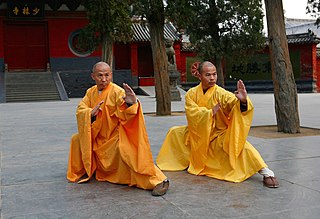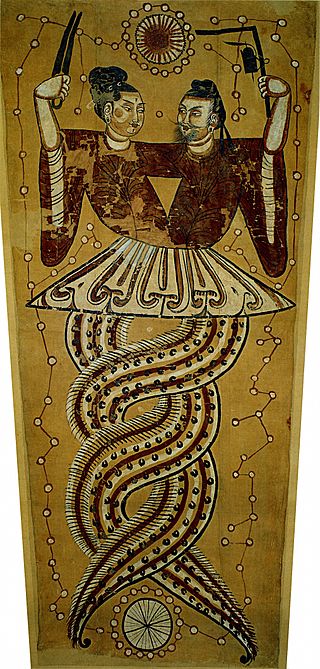
Wuxing, usually translated as Five Phases or Five Agents, is a fivefold conceptual scheme used in many traditional Chinese fields of study to explain a wide array of phenomena, including cosmic cycles, the interactions between internal organs, the succession of political regimes, and the properties of herbal medicines.

Yin and yang, also yinyang or yin-yang, is a concept that originated in Chinese philosophy, describing an opposite but interconnected, self-perpetuating cycle. Yin and yang can be thought of as complementary and at the same time opposing forces that interact to form a dynamic system in which the whole is greater than the assembled parts and the parts are a important for cohesion of the whole.
Chinese astrology is based on traditional Chinese astronomy and the Chinese calendar. Chinese astrology flourished during the Han dynasty.

The Pig or sometimes translated as the Boar is the twelfth of the 12-year cycle of animals which appear in Chinese zodiac, in relation to the Chinese calendar and system of horology, and paralleling the system of ten Heavenly Stems and twelve Earthly Branches. Although the term "zodiac" is used in the phrase "Chinese zodiac", there is a major difference between the Chinese usage and Western astrology: the zodiacal animals do not relate to the zodiac as the area of the sky that extends approximately 8° north or south of the ecliptic, the apparent path of the Sun, the Moon, and visible planets across the celestial sphere's constellations, over the course of the year.

The rabbit is the fourth in the twelve-year periodic sequence (cycle) of animals that appear in the Chinese zodiac related to the Chinese calendar. The Year of the Rabbit is associated with the Earthly Branch symbol 卯. the element Wood in Wuxing theory and within Traditional Chinese medicine the Liver Yin and the emotions and virtues of kindness and hope.

The Ox is the second of the 12-year periodic sequence (cycle) of animals which appear in the Chinese zodiac related to the Chinese calendar, and also appears in related calendar systems. The Chinese term translated here as ox is in Chinese niú , a word generally referring to cows, bulls, or neutered types of the bovine family, such as common cattle or water buffalo. The zodiacal ox may be construed as male, female, neutered, intersex, and either singular or plural. The Year of the Ox is also denoted by the Earthly Branch symbol chǒu. The term "zodiac" ultimately derives from an Ancient Greek term referring to a "circle of little animals". There are also a yearly month of the ox and a daily hour of the ox. Years of the oxen (cows) are cyclically differentiated by correlation to the Heavenly Stems cycle, resulting in a repeating cycle of five years of the ox/cow, each ox/cow year also being associated with one of the Chinese wǔxíng, also known as the "five elements", or "phases": the "Five Phases" being Fire, Water, Wood, Metal, and Earth. The Year of the Ox follows after the Year of the Rat which happened in 2020 and is then followed by the Year of the Tiger, which happened in 2022.

The Rat or Mouse is the first of the repeating 12-year cycle of animals which appear in the Chinese zodiac, constituting part of the Chinese calendar system. The Year of the Rat in standard Chinese is Chinese: 鼠年; pinyin: shǔnián. The rat is associated with the first branch of the Earthly Branch symbol 子 (zǐ), which starts a repeating cycle of twelve years. The Chinese word shǔ refers to various small rodents (Muroidea), such as rats and mice. The term "zodiac" ultimately derives from an Ancient Greek term referring to a "circle of little animals". There are also a yearly month of the rat and a daily hour of the rat. Years of the rat are cyclically differentiated by correlation to the Heavenly Stems cycle, resulting in a repeating cycle of five years of the rat, each rat year also being associated with one of the Chinese wu xing, also known as the "five elements", or "phases": the "Five Phases" being Fire, Water, Wood, Metal, and Earth.

In Western astrology, astrological signs are the twelve 30-degree sectors that make up Earth's 360-degree orbit around the Sun. The signs enumerate from the first day of spring, known as the First Point of Aries, which is the vernal equinox. The astrological signs are Aries, Taurus, Gemini, Cancer, Leo, Virgo, Libra, Scorpio, Sagittarius, Capricorn, Aquarius, and Pisces. The Western zodiac originated in Babylonian astrology, and was later influenced by the Hellenistic culture. Each sign was named after a constellation the sun annually moved through while crossing the sky. This observation is emphasized in the simplified and popular sun sign astrology. Over the centuries, Western astrology's zodiacal divisions have shifted out of alignment with the constellations they were named after by axial precession of the Earth while Hindu astrology measurements correct for this shifting. Astrology was developed in Chinese and Tibetan cultures as well but these astrologies are not based upon the zodiac but deal with the whole sky.
The zangfu organs are functional entities stipulated by traditional Chinese medicine (TCM). These classifications are based on east Asian cosmological observations rather than bio medical definitions that are used in Western evidence based medical models. In TCM theory they represent the energetic representation of the internal organs rather than the anatomical viscera that is referred to in Western medicine.
The model of the body in traditional Chinese medicine (TCM) has the following elements:
In Chinese philosophy, metal or gold, In the Wu Xing, it is the return or the declining stage. In Traditional Chinese Medicine Metal is yang within yin in character, its motion is going inwards and its energy is contracting. It is associated with the west, dusk, autumn, fall and old age, loss and grief. It governs the Yin, Zang organ the Lung and the Yang, Fu organ colon, nose and skin, body hair, pungent smell, the planet Venus, the color white, dry weather, and the White Tiger in Four Symbols. The archetypal metals are silver or gold.
According to traditional Chinese medicine, the kidney refers to either of the two viscera located on the small of the back, one either side of the spine. As distinct from the Western medical definition of kidneys, the TCM concept is more a way of describing a set of interrelated parts than an anatomical organ. In TCM, the kidneys are associated with "the gate of Vitality" or "Ming Men". A famous Chinese doctor named Zhang Jie Bin wrote "there are two kidneys,, with the Gate of Vitality between them. The kidney is the organ of water and fire, the abode of yin and yang, the sea of essence, and it determines life and death."
Astrology has used the concept of classical elements from antiquity up until the present. In Western astrology and Sidereal astrology four elements are used: Fire, Earth, Air, and Water.

The bagua (Chinese: 八卦; pinyin: bāguà; lit. 'eight trigrams') is a set of symbols from China intended to illustrate the nature of reality as being composed of mutually opposing forces reinforcing one another. Bagua is a group of trigrams—composed of three lines, each either "broken" or "unbroken", which represent yin and yang, respectively. Each line having two possible states allows for a total of 23 = 8 trigrams, whose early enumeration and characterization in China has had an effect on the history of Chinese philosophy and cosmology.

In Chinese martial arts, there are fighting styles that are modeled after animals.
In Chinese philosophy, fire is the second phase of Wu Xing.
In Chinese philosophy, earth or soil is one of the five concepts that conform the wuxing. Earth is the balance of both yin and yang in the Wuxing philosophy, as well as the changing or central point of physical matter or a subject. Its motion is centralising, and its energy is stabilizing and conserving.
In Chinese philosophy, water is the low point of matter. It is considered matter's dying or hiding stage. Water is the fifth of the five elements of wuxing.
Xuan Kong Flying Star feng shui or Xuan Kong Fei Xing is a discipline in Feng Shui, and is an integration of the principles of Yin Yang, the interactions between the five elements, the eight trigrams, the Lo Shu numbers, and the 24 Mountains, by using time, space and objects to create an astrological chart to analyze positive auras and negative auras of a building.

Snakes are an important motif in Chinese mythology. There are various myths, legends, and folk tales about snakes. Chinese mythology refers to these and other myths found in the historical geographic area(s) of China. These myths include Chinese and other languages, as transmitted by Han Chinese as well as other ethnic groups.









